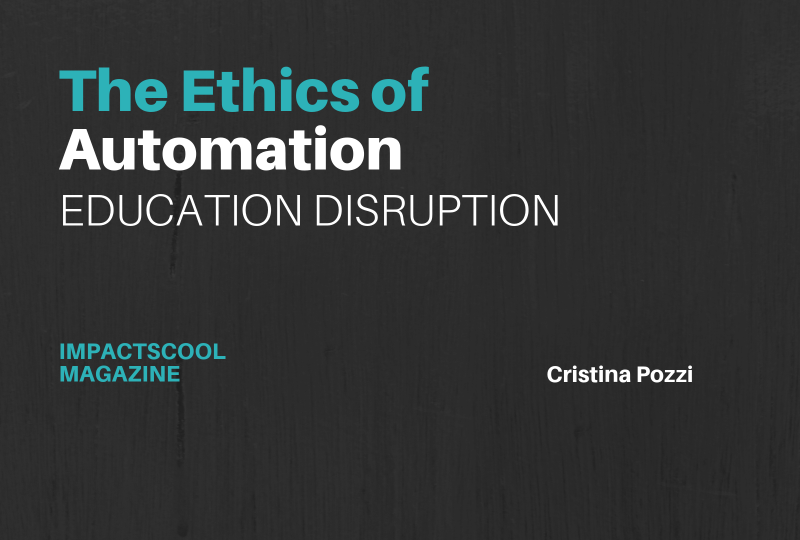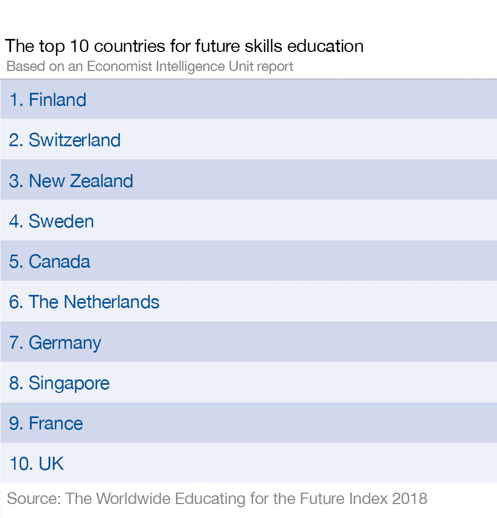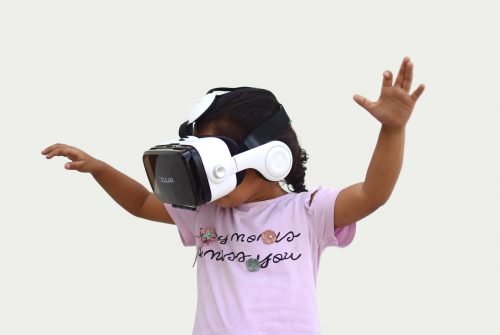The Ethics of Automation: EDUCATION DISRUPTION
10 May 2019 | Written by Cristina Pozzi
The process of industrial automation brings with it impacts on the job market, which requires interventions on the training of every order and degree. This need is a responsibility that concerns everyone: the developer, the user and the legislator. The education is one of the fields of ethical impact in artificial intelligence and new technologies that I propose to address in this series of articles.

The guidelines drafted by the European Commission’s group of high-level experts have been released in their first draft in December 2018 and a few weeks ago, in a final version. This document addresses the issue of how to adopt a Trustworthy and speaks expressly about the topic of education, both in terms of dissemination and information of the public, and of job training. However, the impacts of artificial intelligence on jobs are pervasive and linked to education at all levels: for schools, to respond to medium/long-term changes jobs scenarios, and for university and professional, to respond to short term scenarios. From a school perspective, the aim is to train the professionals of tomorrow and from a university/professional perspective is to create and make available in market the skills needed to answer to the 4th Industrial Revolution.
This article has no ambition to offer an exhaustive treatment of the subject of the education of the future, which is one of the most complexes of our century but will try to suggest some useful points of view for our reflection.
At first, I will try to analyse the theme in a traditional perspective, in which the primary interest of education is the production of economic value. Afterwards, I will also try to explore a different approach, which could represent the true Copernican revolution that we will see in the coming years.
THE TRADITIONAL POINT OF VIEW
Even when we talk openly about a disruption in the world of education, we are still conservative as we are moving very often into a recent framework, which we take for granted. The education system as we know it is, in fact, the result of the Industrial Revolution and expresses the views of Capitalism as described by J.Stuart Mill in the nineteenth century. Education, under this framework, revolves around the concept of human capital as a way to enhance the contribution that future workers can make to a country’s Gross Domestic Product.
Education, whose value thus becomes quantifiable, in this perspective is no longer just a civil right but also an interesting form of investment for those governments that know how to consider a medium-long time horizon.
The interests of the individual meet those of collectivity and the ability of the industries to absorb workers guarantees that the system is effective. Today this mechanism is in crisis: the system trembles without a continuous trend of economic growth and with the advent of automation process, which causes drastic changes.
In fact, we are not able to align supply and demand under two different points of view.
First of all production times (training and the consequent supply of workers) are not quick enough to meet the demand of companies, and secondly, workers that are newly available on the job market have skills that companies do not need. To put it more simply: new jobs are born but few workers are able to perform them and at the same time, many workers come to the job market with skills that companies do not need any more. This concept is often referred to as Skills Mismatch.
How to intervene?
We can distinguish two types of interventions based on the time span taken into consideration.
Important: both interventions have equal priority. When we are on a sinking boat with damages in the keel, we must remove the water that is entering but at the same time repair the fault. If you do not do both, you sink anyway. The first intervention helps us in the short term; the second allows us not to find ourselves constantly in the skills mismatch situation long term.
Therefore, we must intervene immediately both in creating the new professionals required by the market for the benefit of economy and citizen and, at the same time, we must intervene on the entire education system in place. This second set of actions is particularly complex because it requires us to decide now how to intervene for a future we do not know.
Let’s proceed for steps.
1. Medium-long term point of view: educating the youngest
Let us start with medium-long term needs. In this case, we must focus on school and, therefore, on the youngest kids.
If we train correctly kids today, in 15 years, when entering the job market, we can have solved some parts of the mismatch we see today.
However, how should we train young people if we do not know in what context they will be working?
The recent WORLDWIDE EDUCATING FOR THE FUTURE INDEX 2018, issued for the second year by The Economist and the Yidan Prize foundation, has compiled a ranking of the countries that are more advanced in education. Finland and Switzerland are in first and second place, rewarded for their ability to formulate and revise education-related policies in a continuous mechanism willing to make sure that the useful skills for the future are taught.

Italy and school innovation
Italy in this index ranks twenty-second out of fifty countries, with a gap from the first that is quite significant in terms of absolute value: Finland has a total score of 80.9 out of 100, Italy 56.6 out of 100.
The researchers based the score on the adaptive capacity of the regulatory system and on the socio-economic environment.
Adapting the school system is a long and expensive operation that does not return results in the short term. For this reason, it becomes difficult in a framework of political instability to invest in a deeper change.
Furthermore, if we wanted to do it with the help of private institutions, we would not have more luck considering that it is an unprofitable activity: these solutions, in fact, manage to be sustainable only with expensive rates for students and their families. This not only does not solve the problem, but it could create social inequality between those who have been able to develop new skills and those who cannot afford to do so.
Pathways oriented towards the future
To date, if we want to enrol a student in a future-oriented education path, the tools available in Italy are:
- private schools;
- individual state-of-the-art experimental institutions at a local level (there are great excellence scattered throughout the territory, but still too few to be available for everyone. In this case the unequal access is due to geographical issues);
- corporates organizing activities in schools through the “Alternanza Scuola Lavoro”, an Italian school-work experience project, or Social Corporate Responsibility projects;
- foundations that promote training activities for students and teachers;
- companies that work in the research, selection and administration of personnel who are already training from the upper secondary school level in order to have invested in the availability of job profiles meeting their customers’ needs.
An obstacle to the evolution of the public system is that the rewarding mechanisms towards teachers and school principals are almost non-existent and the tools available for individual initiatives sometimes remain unused due to a motivation gap or because they are sinking in bureaucracy.
It is very important to note that the problem is not a lack in vision: the Ministry of Education has drawn up a very clear and coherent plan including the introduction of new and interesting methodologies studied and applied also in other countries.
In the “Piano Nazionale della Scuola Digitale” (the Italian National Digital School Plan) we talk about STEM subjects, reduction of gender disparity, interactive methods, flipped classroom, peer education, etc. The problem is the execution: we have to reconvert the process and to train the teachers for this new approach to education. And we are talking about a group of more than 800.000 teachers in 2018/2019.
How to intervene?
There are three mandatory interventions at this level:
- offering students, who are still attending traditional courses, a supplementary training;
- training teachers currently at work, so that they can start using new methodologies and bring new knowledge into the classroom;
- training young future teachers in a modern way (by universities and training institutions for teachers).
There is another important issue to consider: focusing on gender equality in STEM subjects is not only a good idea in terms of women’s rights, but also from the point of view of economic growth. If we do not include women among those, who can fill the new jobs offered by the technological revolution we would not have enough workers to meet market needs.
To achieve this ambitious goal it is mandatory to work on inspiration of girls starting at a very young age to show them that a future in which they can follow studies and careers in this field is possible for them to choose.
What does Impactscool do in this context?
Impactscool non-profit activities are offering, also through a protocol of agreement signed with the Ministry of Education in early 2018, training for teachers (point b) of secondary high schools and for students (point a) from the age of 14 (secondary high schools + university).
The program provides:
-
- knowledge about emerging technologies, in order to provide a basic understanding of what they are and how important they can be in the future;
- new teaching methods: i.e. debates, role-playing games, hackathon, design thinking;
- the introduction of a new subject providing tools of awareness and responsibility about the great global issues of our time: the future.
However, what is the use of studying the future at school?
The teaching methods used by Impactscool develop the following soft skills and attitudes, which are increasingly required in our time:
- critical thinking;
- abstraction and creativity;
- problem solving;
- communication skills;
- collaboration skills;
- analytical reasoning;
- logical-deductive reasoning;
- ability to be actors in a peer education context.
Countries such as Australia, Great Britain, the United States and Finland have been testing Future Studies in for decades in some cases.
A guided reflection could help boys and girls to understand their sense of the future (individual and collective) and to orient it: consequently becoming more aware of their role in influencing the future.
The process follows the following steps:
- asking open questions;
- learning to do rigorous research;
- revealing creative solutions based on logical conclusions;
- leading to a profound reflection on ethical and social issues.
Learning to reflect responsibly on possible future scenarios and their possible implications is a skill that transcends specific subjects and that lives beyond the class by creating responsible citizens.
All the materials that are used by Impactscool are provided free of charge to teachers in the creative commons formula so that they can replicate the activities independently.
Activities multiply every day. Thanks to the teachers trained and thanks to the Impactscool Ambassadors, volunteers who support the non-profit sector in their free time and with their skills.
In a few weeks, a book designed to enable educators or parents to do these “future exercises” with great ease even with the kids starting from 6 years old will be available.
2. Short term point of view: giving tools to the market
In the short term, we can highlight the following needs:
- provide companies that wish to invest in new technologies, which are crucial for economic development, the profiles (technicians, data-scientists, researchers), reconverting those who are employed today into jobs that are going to be replaced in the short term by a robot or an algorithm and training young people entering the job market;
- provide training for companies and citizens to understand the changes underway and make the best use of the available tools. If, for example, my company adopts an artificial intelligence software for recruiting, I must be able to read the data and the answers that it offers me critically and understand its limits but also its potentials.
The short-term view may seem at first glance the most urgent: without these conditions companies cannot compete on a global level, social pressure becomes too hard and hinders growth, not to mention that the use of new technologies without the necessary understanding by the user can result in a negative social effect.
Who can take on this type of training?
In this case, we have different approaches:
- companies looking for specialized personnel taking charge directly of the training process in order to introduce the new resources into their staff or to update those already present;
- foundations and local authorities that offer professional training to those in need to find a new job;
- personnel selection companies that organize training activities to meet the needs of client companies;
- master degrees offered by universities;
- universities, which could offer flexible and short-term training to those already in the job market willing to develop new skills for the future: micro-degrees or courses that can be used individually with a timetable accessible to those who work, not available today*;
- professional associations that organize training and professional updating for the associated priors;
- private training institutions that offer specialization courses paid by the future worker;
- the government that provides training funds to be spent in these contexts.
This area of intervention is apparently simpler from a certain point of view since, as there is immediate demand, it is possible for the subjects mentioned to operate with a measurable and concrete economic return. However, the issue of possible inequalities is likely arises here and we risk to leave behind those who are unable to access one of the options mentioned or are not even aware of their own needs in this regard.
What does Impactscool do in this context?
When a company decides to adopt a new technology or radically change the way it works, it becomes very important to share the new vision with all the members of the organization.
Impactscool works with companies in order to provide the basic tools of awareness regarding technological and social changes as well as tools for reflecting on the future as a strategic element for the corporate vision.
Activities range from curating events with speakers to internal training, to completely customized projects. Impactscool manages this part through a for-profit activity that allows the funding of the non-profit initiatives. Impactscool also organizes free events thanks to the support of Impactscool Ambassadors. In fact, our organization is launching some local hubs, called Impactscool Future Vision Hubs, which organize periodic dissemination events open to everybody.

THE IMPACTSCOOL INTERVENTION MODEL

THE PILLARS OF IMPACTSCOOL
A COPERNICAN REVOLUTION
Now we are ready to adopt a more disruptive system than the one exposed above, changing the point of view as we move from the concept of human capital and focus more on personal growth. How could the education system change for all ages? What should we learn and value?
I start from a consideration: if we educate people with a mechanical process, like machines, machines that are coming on the jobs in an automation process, will be able to replace them. However, if you educate humans as humans, then they will always have something completely different to offer compared to a machine.

COPERNICAN REVOLUTION: A CURIOSITY-CENTERED EDUCATION
Below I have put together a small list of things that, in my opinion, could allow us to restore the centrality of the person in the educational process and to update students skills.
In terms of knowledge there is no need for a Copernican revolution. We only need to update a percentage, an hypothetical 20%, of the traditional school program, to make some subjects more up-to-date. This goes beyond the innovations and experiments already present, except in rare cases.
- Learning to learn. No doubt, it will be increasingly important to be able to constantly learn and reinvent yourself. It will be necessary to do this continuously and often independently considering the increasing trend of freelance workers who will have to take care of their own training. Without the ability to complete a path and to evaluate one’s own results, one risks developing only superficial skills and knowledge. Let us think, for example, about the numerous MOOCs, the online courses that are easily available to everyone today and allow training on infinite subjects. These are one of the fundamental tools for a “lifelong learning” process. However, how many of you have finished all the courses they started? How many would be able to effectively explain to others what they have learned? Above all, would you go tomorrow to take an oral or written exam? If the answer is no, you probably haven’t really learned at the most of your possibilities and maybe this happens because we have all grown up in a system that follows us step by step in the learning project. Noam Chomsky speaks of an educational system that is freely participatory and I believe that this concept expresses well the ability to learn independently by following one’s curiosity.
- We come to the second point: to focus on curiosity and personal growth in order to nourish our passions too. There is nothing more powerful than the motivation that has its roots in passion.
- Precisely because motivation is important, why do we not use gaming mechanisms rather than continuing to use the traditional voting system? In this way, the students have the opportunity to acquire new skills and level up at their own pace.
- Future. Learning to train one’s sense of the future and to navigate change is and will be a fundamental skill and, as highlighted in explaining Impactscool’s activities, it is a methodology able to develop key skills such as critical thinking, creativity, communication, ability to work in groups and make structured analyses, ethical reflection. This dimension of character construction is fundamental to face any future scenario.
- Multidisciplinary: developing the ability to reason in a multidisciplinary way is very important in order to get at a real and deep understanding of the topic of study and also nurtures the ability to learn independently in the future.
- Return to a learning by doing approach rather than the concept of learning going to school that has characterized the last centuries. This requires an openness to experimentation and failure, as well as practical experience. Moreover, this point also means getting out of the classroom, living experiences in the real world, interacting with people.
- And since many certainly think this is a key point, I add that it is correct to imagine learning coding and physics at least in the short term to understand the contemporary and future reality. However, these must not be skills learned with the objective of becoming programmers, because even that type of work could be at risk and because it would fall back into the logic of human capital development.
This kind of scenario would represent an excellent base for a system in continuous ferment, where the learning of new specialized skills based on market demands becomes more effective and efficient. However, the real question is: what is the best social system to sustain the costs of one (the fundamental) and the other (the specializing) type of training? How far should the funds be public and where should they come from companies or individuals?
What does Impactscool do in this context?
Impactscool designed its method and contents to respond to the logic explained above. Working on one or more futures driven by one’s curiosity is a great way to study an interdisciplinary concept, to experiment without there being a right and a wrong thing, to grow as responsible citizens. Among our formats, we have also created a Hackathon format that includes some gamification into the learning mechanism, thanks to the competitive component.
Since this revolution is long and complex, starting to exercise and test a method of this type with programs that can reach 60 hours a year is the first start and allows to offer more tools to those already in school and to pave the way for a deeper change.
APPENDIX: SOME INTERESTING CASE STUDIES
Certainly not exhaustively, I add some examples that can be useful for our reflection.
A) The case of China
A few weeks ago, the news was that in China all students aged 14 and over would learn artificial intelligence.
The reform is part of the strategy of the Asian giant to become the undisputed leader in research and development of AI by 2030.
B) Bocconi University has included Phyton programming among its students’ courses to give everyone an initial idea of what AI and computer programming are. Moreover, any work of the future will certainly have something to do with this technology.
C) Finland’s plan: a plan to train 1% of the population on artificial intelligence in order to reconvert the economy of the country, also considering the decline of the Nokia giant that for years has driven the economy. The plan is to train around 55,000 people on key AI concepts and gradually increase the number over the next few years.
What was initially a free university course evolved into a national program funded thanks to the support of 250 companies and the government.
From a strategic point of view, Finland has decided to focus on the practical applications of this technology, well aware of the fact that it could hardly compete with the basic research carried out by the USA and China.
The course goes in this direction: it does not require programming skills but offers an overview of artificial intelligence and the opportunities and risks it brings with it. The goal is to provide the tools to decide which uses of this technology can be positive and how they would like their government to invest the funds available.
D) Digital Opportunity Traineeship
Even with a high rate of youth unemployment today there are more than 3 million new positions published in Europe by EURES, the European Jobs Network.
Only for the ICT sector, there are 400,000 jobs not covered in Europe and around 40% of companies have enormous difficulties they when look for resources in this field. In this regard, the European Commission estimates that by 2020 vacancies will be almost doubled.
Fortunately, there are initiatives that seek to reduce this gap, such as the Digital Opportunity Traineeships, which will support up to 6,000 students by 2020 in the development of digital skills needed: cybersecurity, big data, quantum technology and machine learning, digital marketing or software development.
Students will receive 500 euros per month that can increase thanks to additional funds from companies, for a period of 2 to 12 months.
Other examples are the work of the Siemens Foundation with the Middle-Skill Initiative to train young people entering the job market in order to make them ready for work in STEM areas. Year Up, which trains around 4,000 young people a year. The initiatives of companies like Salesforce with its Pathfinder program, developed with Deloitte to provide the technical and business skills needed to join the Salesforce team, or the IBM Skills Academy platform.





